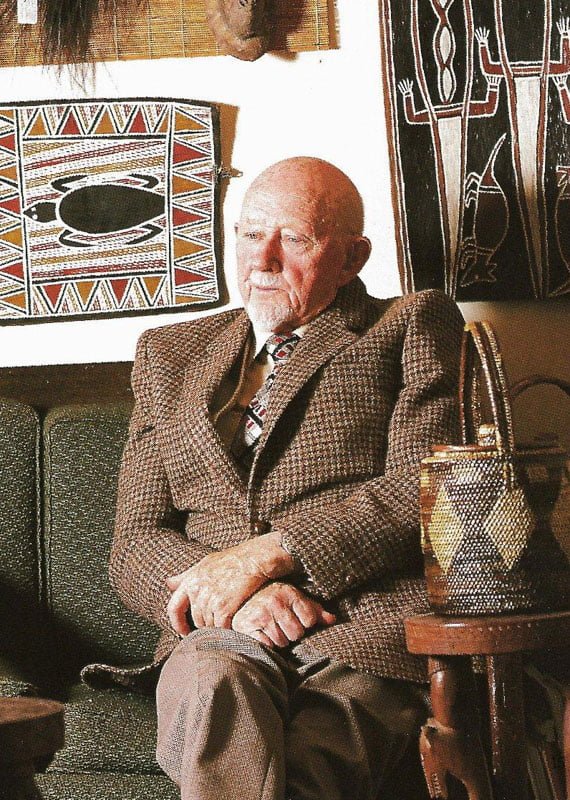
James (Jim) Albert Davidson was born 31st March 1908 at Landybrandt in Orange Free State, South Africa to an Australian father and a South African mother. Jim’s initial schooling with his siblings (2 brothers and 1 sister) was with home tutors. Jim recounted his early childhood as “wonderful,” he was allowed to roam freely with other Zulu children to hunt wild turkeys and pea hens. Possibly, at this early stage Jim’s love of anthropology developed. A stint at boarding school in Pretoria and finally Jim graduated in South Africa in Mining and Engineering, this completed his early formal education
Jim returned to Australia in 1929. His first work in Australia was at the Mt Lyall mine in Tasmania. After 3 years in Tasmania Jim returned to Melbourne where work was very difficult to find and ended up accepting a position on a ketch, transporting sheep between Flinders Island and Tasmania and re supplying the light houses on this route. Jim finally found work in gold exploration and surveying. His appointments took him to Fiji, Samoa, Tonga. Jim was fortunate to meet Margaret Mead, the famous anthropologist during this time. He described her as an extraordinary woman and their conversations re kindled Jim’s interest in Pacific Islanders art and culture. Jim further explored Pacific art and culture at the Bishop Museum in Honolulu.

In 1937 Jim was commissioned to explore and map uncontrolled territory in New Guinea. Jim spent a lot of his time on the Fly River and once again was fascinated by the art and culture of the indigenous people of this region. Jim returned to Papua New Guinea post war and grew coffee in the Whagi Valley in the Highlands. His collection of artefacts during this time gives insight into his deep respect for the people of this area.
In 1960 Jim visited Arnhem Land for the first time. He immersed himself in the language of Gupupungu tribe and studied the art and culture of this land. Jim regularly visited Yirrkala and Milingimbi and developed a special affinity with the Yolngu (Aboriginal people form North East and Central Arnhem Land). Jim’s closest friend at Yirrkala was Mathaman (1920-1970) a member of the Rirradjinggu clan and leader of the Dhuwa moiety. Mathaman was a great artist, warrior and ceremonial leader. Mathaman and Jim’s respect for each other led to Jim to be initiated into the Gomaidj clan of the Yirritja moiety. During his visits to this area Jim photographed prominent artists and documented their stories and detailed what the artist were allowed to paint
Jim and his wife Rene opened the Aboriginal and Pacific Art Gallery in 1961 at their home in Ivanhoe, a suburb of Melbourne, Australia. The gallery displays a vast array of bark paintings and artefacts collected over many years form the Pacific region and Arnhem Land. Jim’s photography and his oral sharing of his knowledge of the great artists of the Yolngu such as Mathaman, Mawalan and Narritjin demonstrated Jim’s great respect of the Yolongu society
The National Gallery of Victoria recognised Jim’s services to indigenous art and appointed him as a life member in 1991. His association with the Gallery however dated back to 1961 when he donated two barks paintings from Yirrkala from his collection. (Larrtjannga Ganambarr’s Freshwater goannas 1960 and Gunguyuma’s Djambuwal, the thunderman, 1961). Jim donated in 1967 Mathaman’s Wawilak Ceremony, (1963) to not only celebrate the move of the Gallery to its new home on St Kilda Road but to demonstrate that by donating his finest collected piece, he firmly believed that Aboriginal art was great art and had a rightful place in a Gallery context. Over the next decade Jim and Rene continued to donate significant pieces of works to the Galleries Aboriginal collection.
Jim died on the 11th October 1994. Jim’s significant legacy was the early recognition and appreciation of Aboriginal art, something we now all take for granted